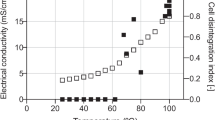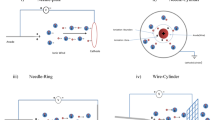Abstract
Conventional de-icing systems use resistive heating wires to prevent the freezing of railway turnouts. Because of the low efficiency of the heating wires, induction heating (IH) systems have been investigated recently. The IH systems utilize high-frequency resonant inverters and heating coils to induce eddy currents and heat energy on heating plates. The heating coils can be manufactured with a printed-circuit-board (PCB) process. However, a short distance between PCB patterns can generate a significant parasitic capacitance, which resonates with the coil inductance. A self-resonance of the coil makes capacitive impedance at high-frequency ranges and distorts coil currents. This paper investigates the parasitic capacitance of PCB-type induction heating coils. Analytic models of the PCB-type heating coil are derived. In addition, a new LCCC/S impedance matching network (IMN) design that compensates for the parasitic capacitance is presented. The developed induction heating coil and IMN are demonstrated using experimental results.














Similar content being viewed by others
References
Dindar S, Kaewunruen S, An M, Gigante-Barrera A (2017) Derailment-based fault tree analysis on risk management of railway turnout systems. IOP Conf Ser Mater Sci Eng. https://doi.org/10.1088/1757-899X/245/4/042020.Joseph
Oh HS, Kim DK, Hong SM, Ryu SG, Park CB, Lee JB, Lee J, Lee HW (2022) Anti-icing system on railway turnouts using insduction heating technology for energy saving. In: 2022 IEEE 21st mediterranean electrotechnical conference (MELECON), pp 342–347. https://doi.org/10.1109/MELECON53508.2022.9842
Oh HS, Park CB, Lee SH, Lee JB, Kim TH, Lee HW (2019) A study on de-icing for railway turnouts using 250kHz–200W-class induction heating system. AIP Adv. https://doi.org/10.1063/1.5129857
Jeong SH, Park HP, Jung JH (2018) Design methodology of 3 kW Induction heating system for both low resistance and high resistance containers in a single burner. In: International power electronics conference (IPEC-Niigata 2018-ECCE Asia) pp 289–295. https://doi.org/10.23919/IPEC.2018.8507579
Han W, Chau KT, Liu W, Tian X, Wang H (2022) A dual-resonant topology-reconfigurable inverter for all-metal induction heating. IEEE J Emerg Sel Top Power Electron 10(4):3818–3829. https://doi.org/10.1109/JESTPE.2021.3071700
Chafi A, Idir N, Videt A, Maher H (2021) Design method of PCB inductors for high-frequency GaN converters. IEEE Trans Power Electron 36(1):805–814. https://doi.org/10.1109/TPEL.2020.3000438
Islam AB, Islam SK, Tulip FS (2013) Design and optimization of printed circuit board inductors for wireless power transfer system. Circuits Syst 4(2):237–244. https://doi.org/10.4236/cs.2013.42032
Serrano J, Lope I, Acero J, Carretero C, Burdio JM, Alonso R (2017) Design and optimization of small inductors on extra-thin PCB for flexible cooking surfaces. IEEE Trans Ind Appl 53(1):371–379. https://doi.org/10.1109/TIA.2016.2602217
Schäfer J, Bortis D, Kolar JW (2020) Novel highly efficient/compact automotive PCB winding inductors based on the compensating Air-Gap fringing field concept. IEEE Trans Power Electron 35(9):9617–9631. https://doi.org/10.1109/TPEL.2020.2969295
Lope I, Acero J, Burdio JM, Carretero C, Alonso R (2015) Design and implementation of PCB inductors with litz-wire structure for conventional-size large-signal domestic induction heating applications. IEEE Trans Ind Appl 51(3):2434–2442. https://doi.org/10.1109/TIA.2014.2382758
Plumed E, Lope I, Acero J, Burdio JM (2022) Domestic induction heating system with standard primary inductor for reduced-size and high distance cookware. IEEE Trans Ind Appl 58(6):7562–7571. https://doi.org/10.1109/TIA.2022.3193107
Hardock A, Dahl D, Brüns HD, Schuster C (2015) Efficient calculation of external fringing capacitances for physics-based PCB modeling. 2015 IEEE 19th workshop on signal and power integrity (SPI) pp 1–4. https://doi.org/10.1109/SaPIW.2015. 7237396
Meng W, Zhang F, Dong G, Wu J, Li L (2021) Research on losses of PCB parasitic capacitance for GaN-based full bridge converters. IEEE Trans Power Electron 36(4):4287–4299. https://doi.org/10.1109/TPEL.2020.3024881
Pajovic M, Yu J, Milojkovic D (2007) Analysis of via capacitance in arbitrary multilayer PCBs. IEEE Trans Electromagn Compat 49(3):722–726. https://doi.org/10.1109/TEMC.2007.902382
Zulauf G, Liang W, Rivas-Davila J (2017) A unified model for high-power, air-core toroidal PCB inductors. In: 2017 IEEE 18th Workshop on control and modeling for power electronics (COMPEL) pp 1–8. https://doi.org/10.1109/COMPEL.2017.80 13401
Sun B, Burgos R, Boroyevich D (2019) Ultralow input-output capacitance PCB-embedded dual-output gate-drive power supply for 650 V GaN-based half-bridges. IEEE Trans Power Electron 34(2):1382–1393. https://doi.org/10.1109/TPEL.2018.2828384
Wurth Elektronik, Niedernhall, Germany. Standard FR4 TG135 Datasheet. Accessed: Aug 15 2022. [Online]. Available:http://www.wedirekt.com/web/mandators/media/16_wedirekt/spezifikationen/leiterplatten_daten_downloads/FR4TG135_UK.pdf
Samwha Electronics, Yongin-si, South Korea. PL-F1. Accessed: Jan. 1, 2022. [Online]. Available: http://www.samwha.co.kr/electronics/
Steel Grades, SUS430. Accessed: Jan. 1, 2022.[Online]. Available:https://www.steel-grades.com/Steel-Grades/Special-Steel/SUS430.html
Arabi TB, Sarkar TK (1988) Analysis of multiconductor transmission lines. In: 31st ARFTG conference digest - Springer. pp 45–54. https://doi.org/10.1109/ARFTG.1988.323901.
Association connecting electronics industries, IPC-2221A, (1998). Accessed: Aug 15, 2022. [Online]. Available:http://www.eng.lbl.gov/~shuman/NEXT/CURRENT_DESIGN/TP/MATERIALS/IPC-2221A(L).pdf
Keysight Technologies, CA, USA. E5061B ENA Vector Network Analyzer. Accessed: Jan 1, 2022, [Online]. Available: https://www.keysight.com/en/pdx-x201771-pn-E5061B/ena-vector-network-analyzer?cc=MY&lc=eng
Vishay general semiconductor, PA, USA. BU1006-M3/45. Accessed: Aug 15, 2022. [Online]. Available: https://www.vishay.com/en/product/84801//
STMicroelectronics, Geneva, Switzerland. STP11N60DM2. Accessed: Aug. 15, 2022. [Online]. Available:https://www.st.com/en/powertransistors/stp11n60dm2.html
Infineon Technologies, Neubiberg, Germany. IDH06G65C6. Accessed: Aug. 15, 2022. [Online]. Available:https://www.infineon.com/cms/en/product/power/diodes-thyristors/coolsic-schottky-diodes/idh06g65c6/
Infineon Technologies, Neubiberg, Germany. IPW60R280P6 Accessed: Aug. 15, 2022. [Online]. Available: https://www.infineon.com/cms/en/product/power/mosfet/n-channel/500v-950v/ipw60r280p6/
TEWA Sensors, Lublin, Poland. TT6–100KC3L-5-AUR Accessed: Aug. 15, 2022. [Online]. Available: https://tewa-sensors.com/products/thermistors/tt-6-series-thin-film-thermistors/
Testo, Titisee-Neustadt, Germany. testo 875–1i-Thermal imager. Accessed: May 4, 2022. [Online]. Available: https://www.testo.com/en-TH/testo-875-1i/p/0563-0875-V1#
Acknowledgements
This work is supported by Korea Agency for Infrastructure Technology Advancement grant funded by Ministry of Land, Infrastructure and transport. (RS-2018-KA146020).
Author information
Authors and Affiliations
Corresponding author
Additional information
Publisher's Note
Springer Nature remains neutral with regard to jurisdictional claims in published maps and institutional affiliations.
Rights and permissions
Springer Nature or its licensor (e.g. a society or other partner) holds exclusive rights to this article under a publishing agreement with the author(s) or other rightsholder(s); author self-archiving of the accepted manuscript version of this article is solely governed by the terms of such publishing agreement and applicable law.
About this article
Cite this article
Oh, HS., Lee, J., Lee, SH. et al. Parasitic Capacitance Analysis of PCB-type Induction Heating Coil and LCCC/S Matching Network Design for Railway Turnouts. J. Electr. Eng. Technol. 18, 3311–3320 (2023). https://doi.org/10.1007/s42835-022-01372-0
Received:
Revised:
Accepted:
Published:
Issue Date:
DOI: https://doi.org/10.1007/s42835-022-01372-0




